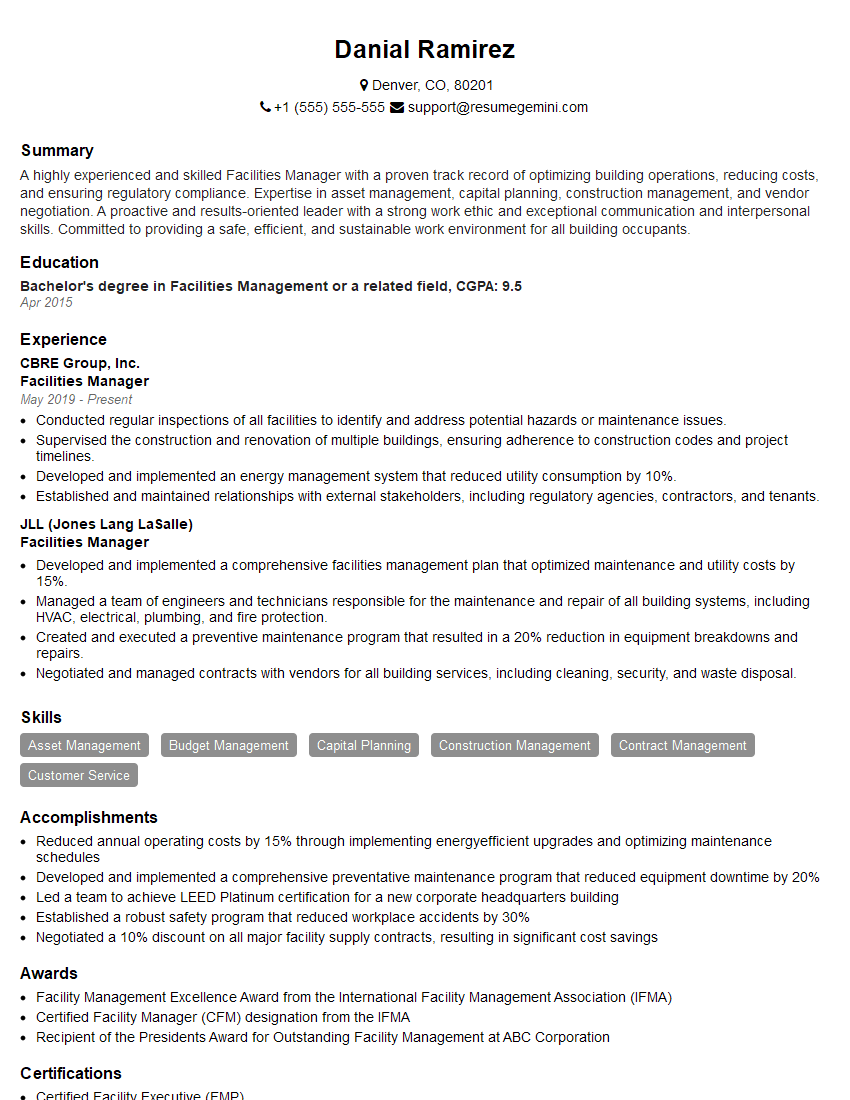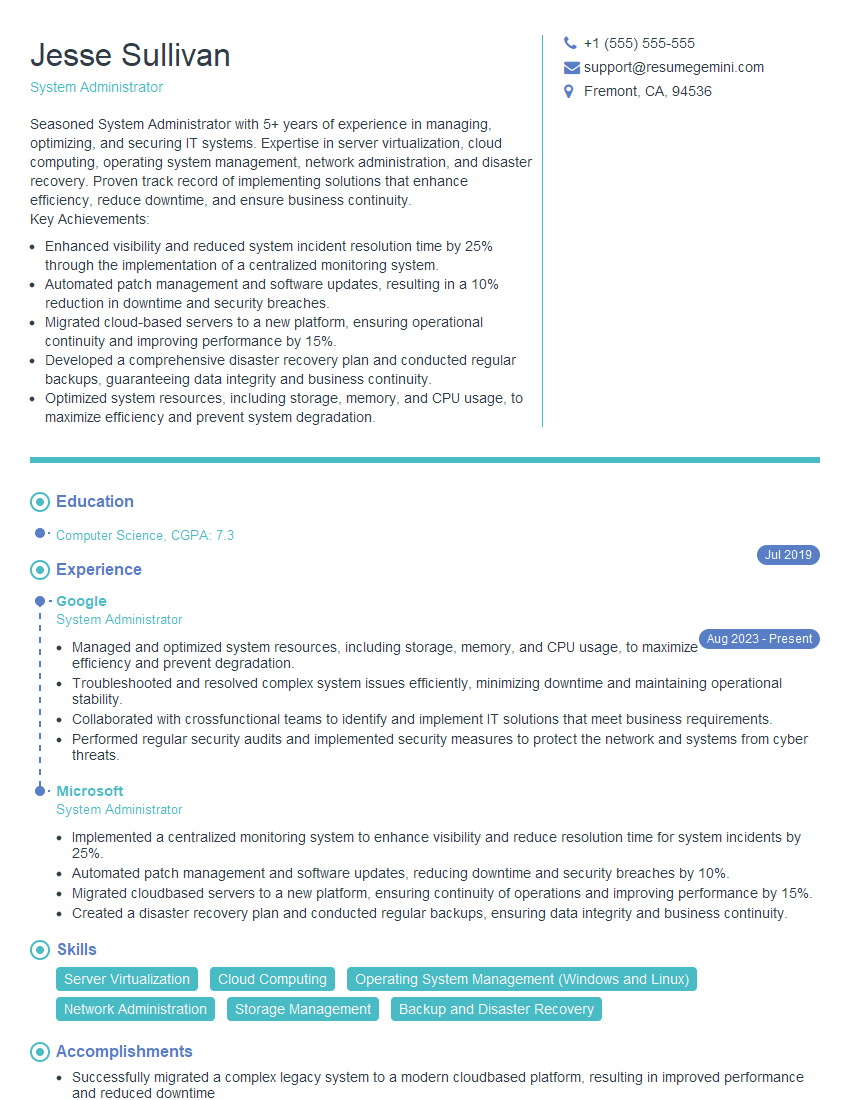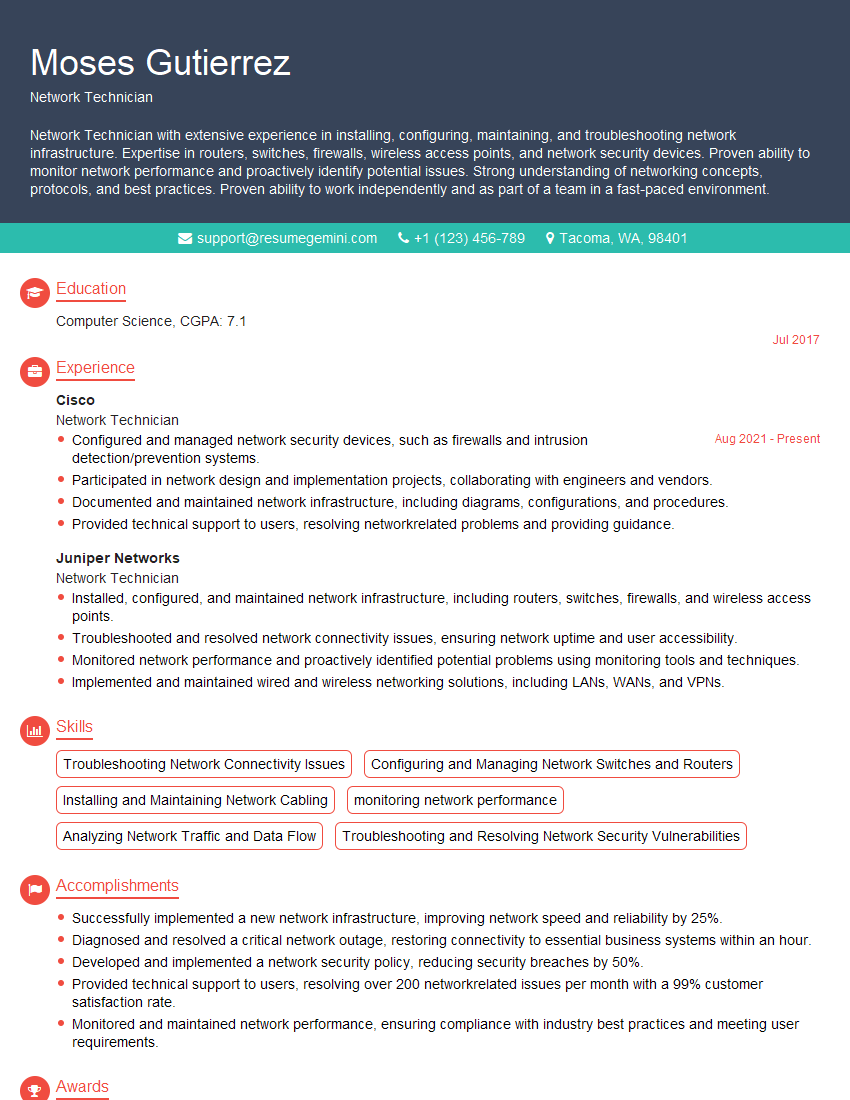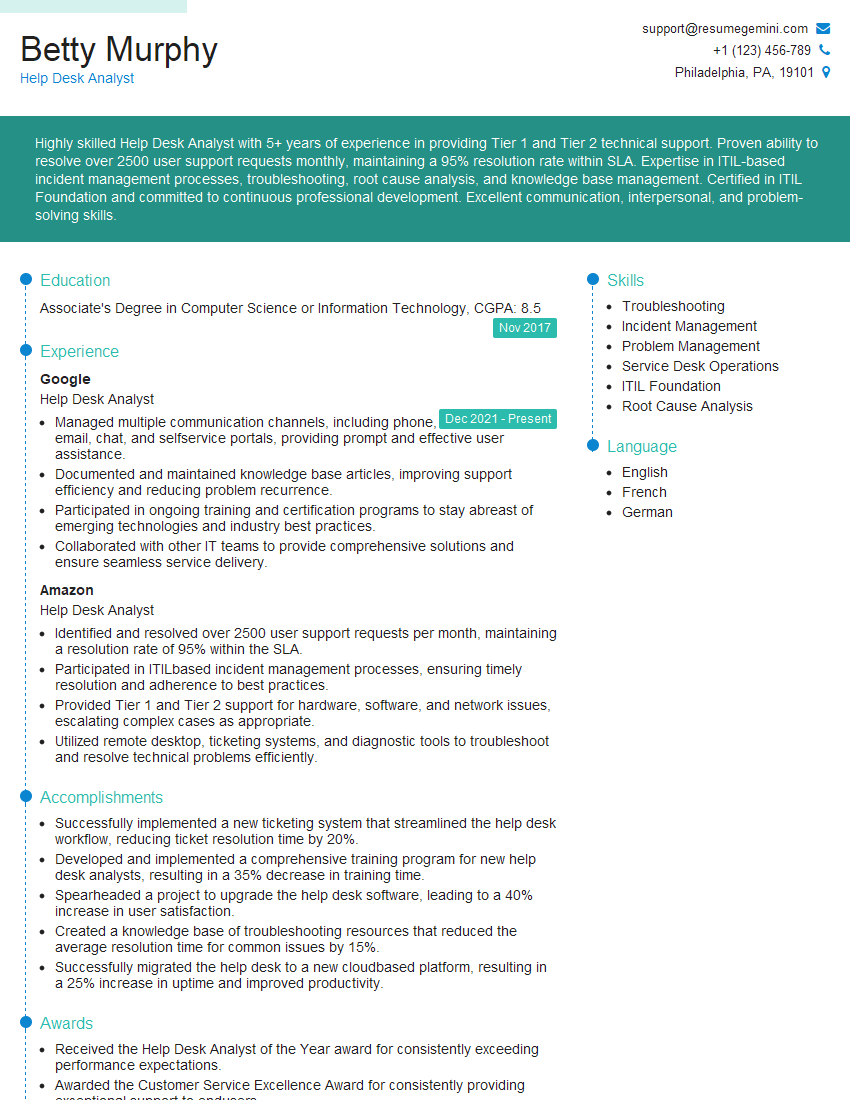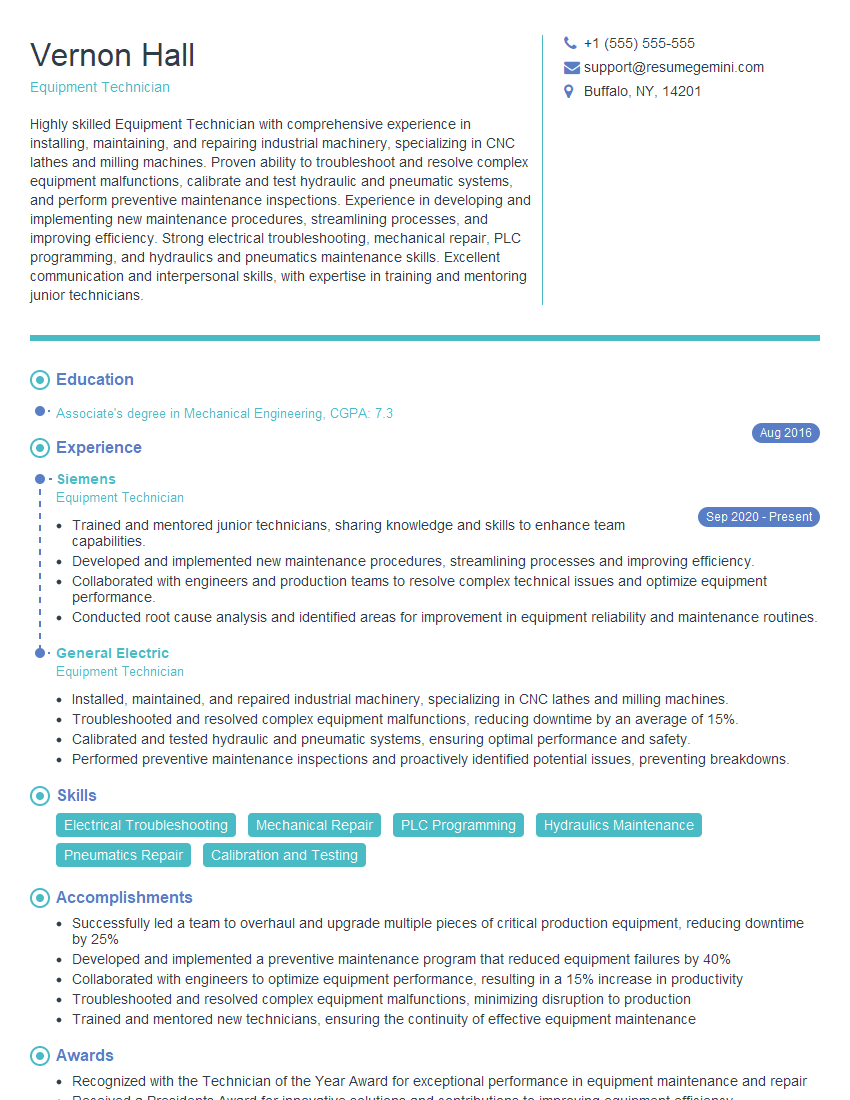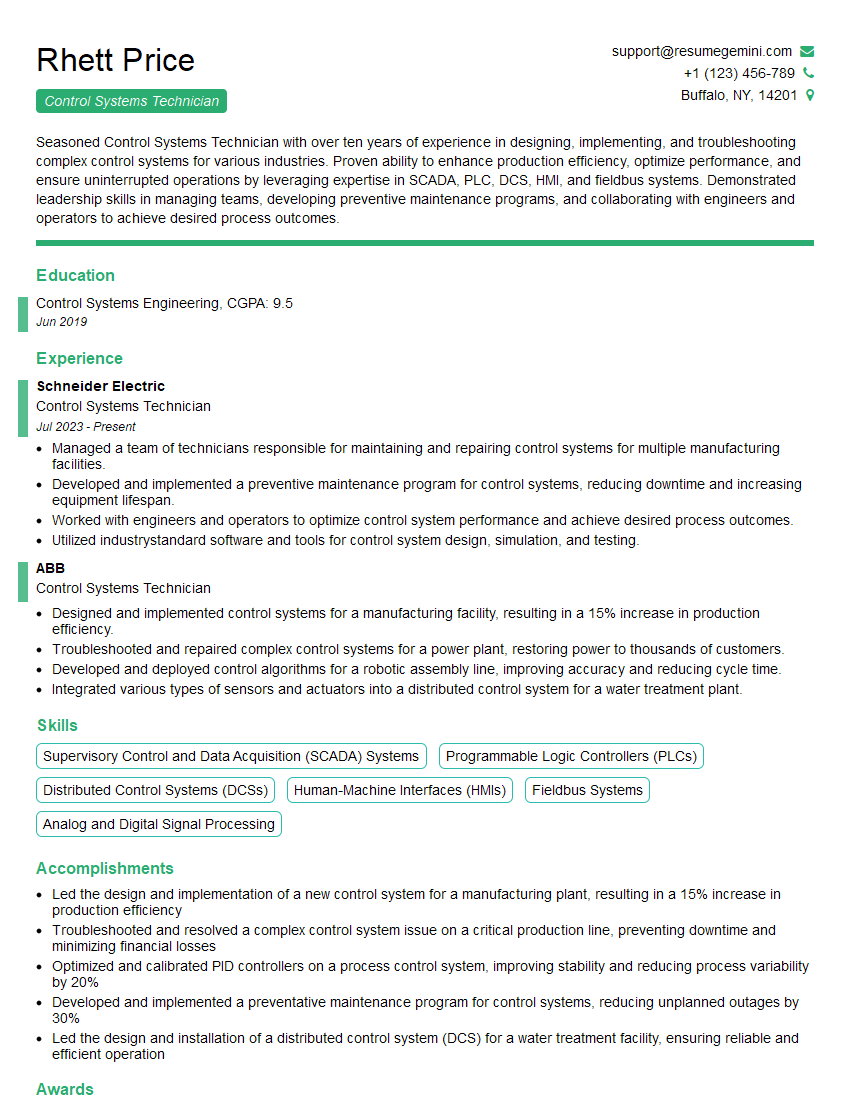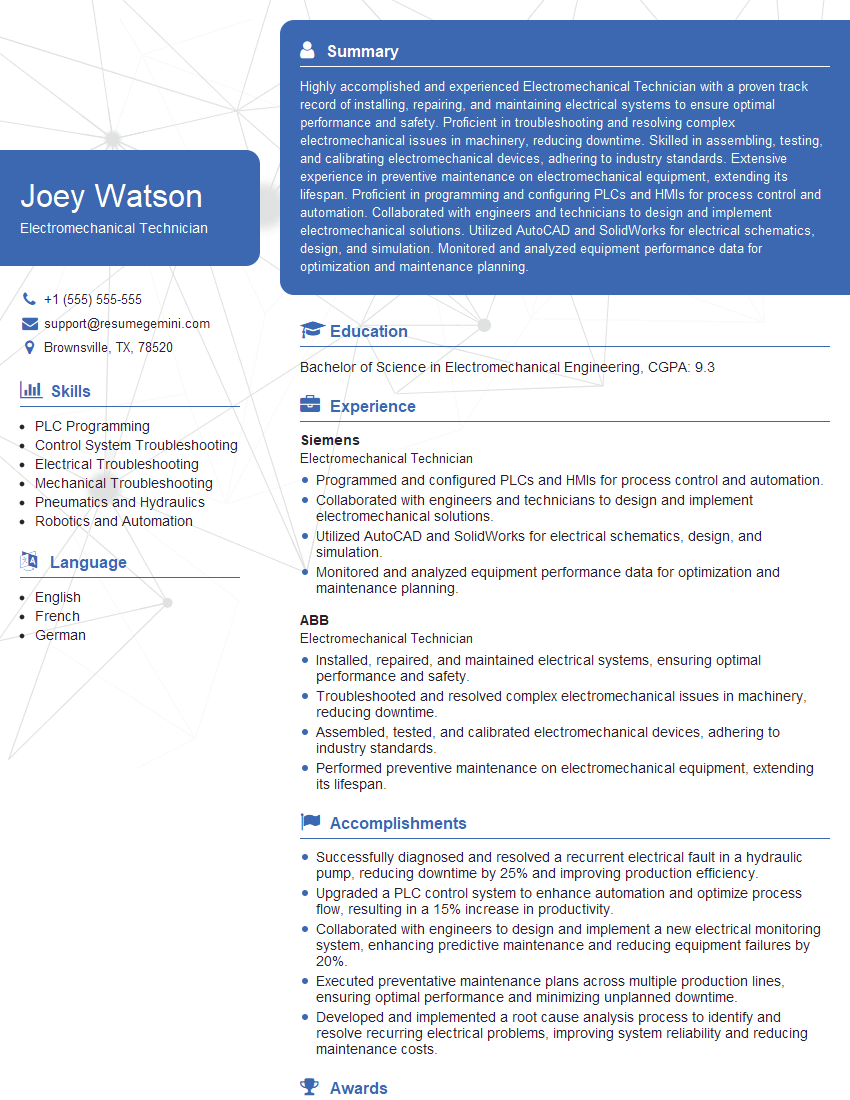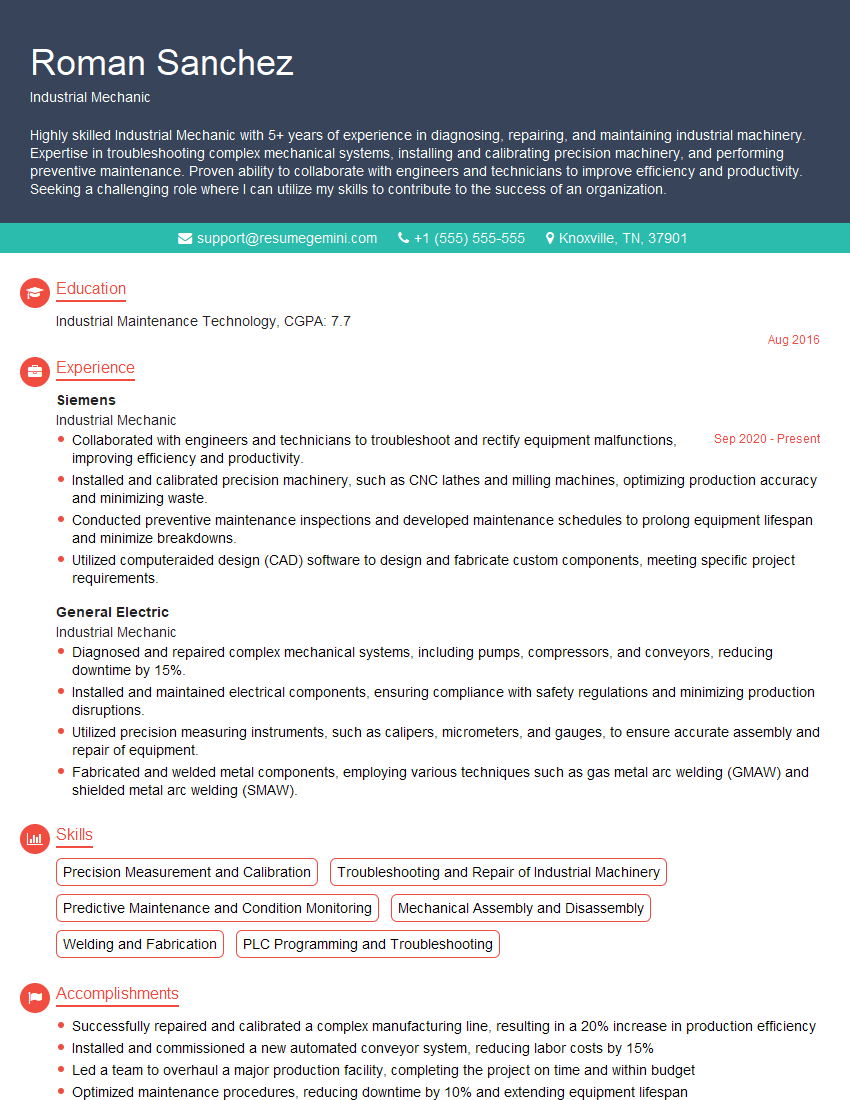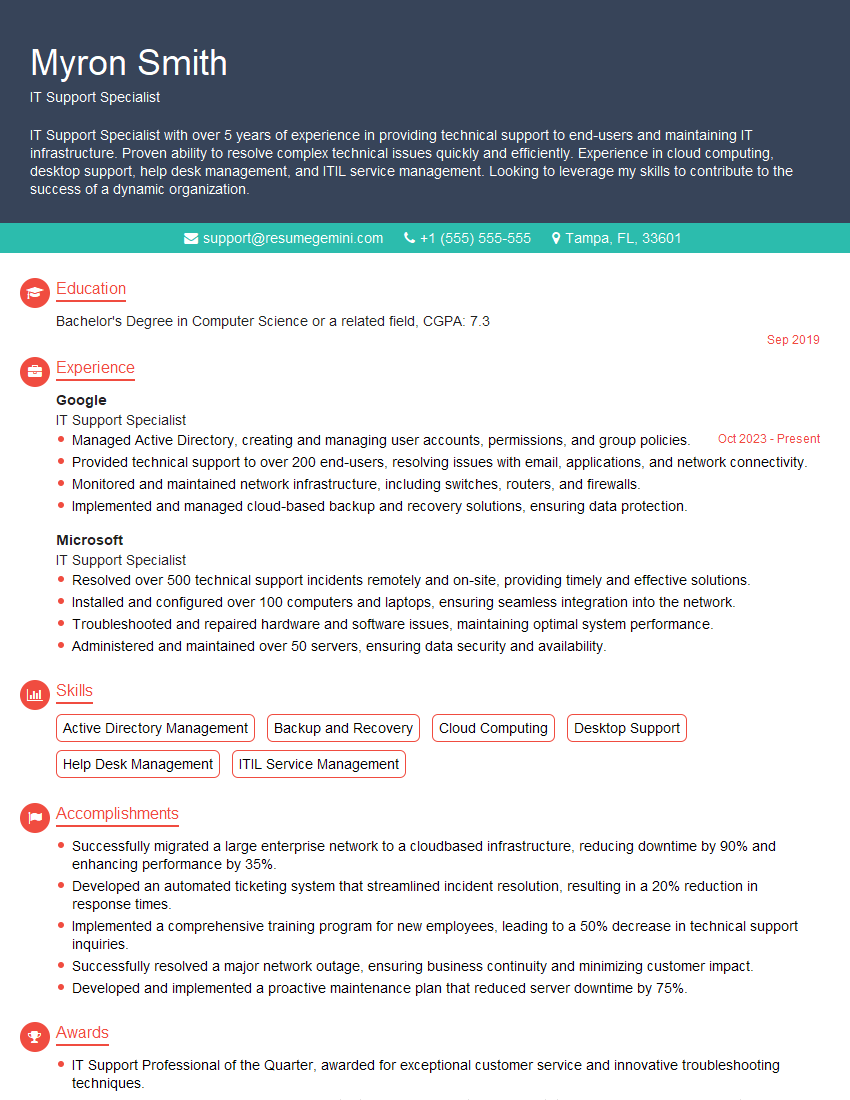Feeling uncertain about what to expect in your upcoming interview? We’ve got you covered! This blog highlights the most important Troubleshooting and Preventive Maintenance interview questions and provides actionable advice to help you stand out as the ideal candidate. Let’s pave the way for your success.
Questions Asked in Troubleshooting and Preventive Maintenance Interview
Q 1. Describe your experience with root cause analysis techniques.
Root cause analysis (RCA) is a systematic approach to identifying the underlying cause of a problem, not just its symptoms. My experience involves using various techniques, including the ‘5 Whys’, fault tree analysis, and fishbone diagrams. For instance, if a production line repeatedly jams, simply fixing the jam isn’t enough. Using the ‘5 Whys’, I’d ask: Why did the line jam? (Answer: Material clumped). Why did the material clump? (Answer: Moisture content too high). Why was the moisture content high? (Answer: Faulty drying process). Why was the drying process faulty? (Answer: Sensor malfunction). Why did the sensor malfunction? (Answer: Lack of preventative maintenance). This reveals the root cause: neglecting preventative maintenance on the drying process sensor. Fault tree analysis offers a more visual and comprehensive approach, mapping out potential causes and their relationships to the final failure. Fishbone diagrams, also known as Ishikawa diagrams, help brainstorm potential causes categorized by different factors (materials, methods, manpower, machinery, measurement, environment). The key is to drill down until you find the fundamental issue driving recurring problems.
Q 2. Explain the difference between preventative and corrective maintenance.
Preventative maintenance (PM) focuses on preventing equipment failures before they occur, while corrective maintenance (CM) addresses failures after they happen. Think of it like this: PM is like regular check-ups at the doctor, catching potential problems early. CM is like going to the emergency room after a heart attack. PM involves scheduled inspections, lubrication, cleaning, and part replacements based on time or usage. CM, on the other hand, involves repairs, troubleshooting, and parts replacement after a breakdown. PM is proactive and aims to maximize equipment uptime and lifespan, minimizing costly repairs and downtime. CM is reactive, often resulting in unexpected production halts and higher repair costs. A well-balanced maintenance strategy incorporates both, prioritizing PM to reduce the need for CM.
Q 3. How do you prioritize maintenance tasks?
Prioritizing maintenance tasks requires a systematic approach. I typically use a combination of factors:
- Criticality: How essential is the equipment to production? A critical piece of machinery gets higher priority than a less important one.
- Risk: What’s the potential impact of failure? A failure with significant safety or production consequences needs immediate attention.
- Cost: What’s the cost of repair versus the cost of downtime? A quick, inexpensive fix might be prioritized over a complex, costly one, especially if the latter can wait.
- Urgency: How imminent is the risk of failure? A machine showing warning signs needs immediate attention.
I often use a CMMS (Computerized Maintenance Management System) to track work orders, schedule tasks, and assign priorities based on these factors. A simple scoring system can be implemented, assigning points to each factor and then ranking tasks based on the total score. This ensures a data-driven approach to maintenance planning.
Q 4. What are some common causes of equipment failure?
Equipment failure has numerous causes, broadly categorized as:
- Wear and Tear: Normal deterioration from use, leading to component wear, fatigue, and eventual failure (e.g., bearing wear in a motor).
- Lubrication Issues: Insufficient or improper lubrication leads to friction, overheating, and premature component failure.
- Environmental Factors: Extreme temperatures, humidity, corrosion, dust, and vibration can damage equipment.
- Operator Error: Incorrect operation, overloading, or neglecting safety procedures contribute to failures.
- Design Flaws: Poorly designed components or systems can lead to frequent failures.
- Lack of Preventative Maintenance: Neglecting regular maintenance is a major cause of premature equipment failure.
Identifying the specific cause requires careful observation, data analysis, and often, root cause analysis techniques.
Q 5. How do you troubleshoot a malfunctioning machine?
Troubleshooting a malfunctioning machine involves a systematic approach:
- Safety First: Lock out/tag out the machine to prevent accidental start-up.
- Gather Information: Note the symptoms (e.g., error codes, unusual sounds, vibrations). Interview operators to understand what led to the failure.
- Visual Inspection: Check for obvious signs of damage (e.g., loose connections, broken parts, leaks).
- Check Operational Parameters: Verify voltage, current, pressure, temperature, and other relevant parameters.
- Use Diagnostics: If the machine has built-in diagnostics, use them to pinpoint the problem area.
- Isolate the Problem: Systematically check each component to identify the faulty one.
- Repair or Replace: Once the faulty component is identified, repair or replace it.
- Testing and Verification: After the repair, test the machine thoroughly to ensure proper operation.
- Documentation: Record the problem, troubleshooting steps, and solution for future reference.
For example, if a conveyor belt stops, I would first check the power supply, then the motor, then the belt itself, looking for damage, obstructions, or loose components. Each step eliminates potential causes until I find the root of the problem.
Q 6. Describe your experience with CMMS (Computerized Maintenance Management System) software.
I have extensive experience with various CMMS software, including [mention specific software you are familiar with, e.g., IBM Maximo, SAP PM]. These systems are crucial for managing preventative and corrective maintenance efficiently. My experience involves using CMMS to schedule PM tasks, track work orders, manage inventory, and generate reports on equipment performance and maintenance costs. I’m proficient in creating customized reports, analyzing equipment reliability data, and using the system to optimize maintenance strategies. For example, I’ve used CMMS data to identify trends in equipment failures, leading to proactive changes in maintenance schedules and reduced downtime. The ability to track maintenance history allows for informed decision-making, leading to improvements in overall equipment effectiveness (OEE).
Q 7. What safety procedures do you follow during maintenance?
Safety is paramount during any maintenance activity. My procedures always prioritize the following:
- Lockout/Tagout (LOTO): Before working on any equipment, I always perform LOTO procedures to isolate the power source and prevent accidental start-up. This is non-negotiable.
- Personal Protective Equipment (PPE): I use appropriate PPE, such as safety glasses, gloves, hearing protection, and steel-toe boots, depending on the task.
- Risk Assessment: Before starting any work, I conduct a thorough risk assessment to identify potential hazards and implement control measures.
- Permit-to-Work System: For high-risk tasks, I follow a formal permit-to-work system, ensuring proper authorization and safety checks are in place.
- Emergency Procedures: I am familiar with emergency procedures and know how to respond to accidents or incidents.
- Following all company safety regulations: I ensure to follow all company safety regulations and best practices.
Safety isn’t just a checklist; it’s a mindset. I believe in a culture of safety, where everyone is responsible for identifying and mitigating hazards.
Q 8. How do you handle unexpected equipment downtime?
Unexpected equipment downtime is a serious issue, impacting productivity and potentially safety. My approach is systematic and prioritizes swift resolution while minimizing further damage. First, I ensure the safety of personnel and the immediate area. Then, I follow a structured troubleshooting process:
- Assess the situation: Identify the affected equipment, the nature of the failure (e.g., complete shutdown, partial malfunction), and any immediate consequences.
- Gather information: Check error logs, operator reports, and any available sensor data. This helps narrow down the potential causes.
- Preliminary diagnosis: Based on the gathered information, I formulate a hypothesis about the root cause. This might involve visual inspection, basic checks (power, connections), or simple tests.
- Systematic troubleshooting: I systematically test my hypothesis, using established diagnostic techniques appropriate to the equipment. This might involve checking circuits, testing components, or running diagnostic software.
- Repair or replacement: Once the root cause is identified, I perform the necessary repairs or replace faulty components. I always prioritize using OEM parts whenever possible to maintain the integrity of the equipment.
- Verification and documentation: After the repair, I thoroughly test the equipment to ensure it is functioning correctly. All steps taken, including the root cause, solution, and time spent, are meticulously documented.
For example, during my time at Acme Manufacturing, a critical conveyor belt unexpectedly stopped. My initial assessment revealed a power failure. After tracing the circuit, I identified a blown fuse. Replacing the fuse restored operation. The entire process was documented, including a preventative measure recommendation to regularly inspect the fuse box.
Q 9. Explain your experience with different types of maintenance schedules (e.g., preventative, predictive, reactive).
My experience encompasses various maintenance schedules, each with its own strengths and weaknesses. Let’s explore three common types:
- Reactive Maintenance: This is a ‘fix-it-when-it-breaks’ approach. It’s simple and cost-effective in the short term but can lead to significant downtime, unexpected costs, and safety hazards. I’ve witnessed this in older facilities with limited budgets, where breakdowns often disrupt production significantly.
- Preventative Maintenance (PM): This involves scheduled maintenance based on manufacturer recommendations or historical data. It aims to prevent failures by performing regular inspections, lubrication, and part replacements. This is a proactive approach that reduces unexpected downtime and extends equipment lifespan. I’ve implemented PM schedules for a range of machinery, from simple pumps to complex CNC machines, using CMMS software to track tasks and ensure adherence to schedules.
- Predictive Maintenance: This sophisticated approach utilizes data analysis (vibration analysis, thermal imaging, oil analysis) to predict potential failures before they occur. This allows for targeted interventions, maximizing efficiency and minimizing waste. I’ve been involved in implementing predictive maintenance programs, using sensor data and machine learning algorithms to forecast equipment health and optimize maintenance scheduling. This is particularly beneficial for critical equipment where downtime is extremely costly.
Choosing the right schedule often involves balancing cost, risk, and the criticality of the equipment. For example, a simple pump might only require reactive or preventative maintenance, while a crucial production line might justify the investment in a predictive maintenance strategy.
Q 10. How do you document your maintenance activities?
Meticulous documentation is crucial for effective maintenance management. I use a Computerized Maintenance Management System (CMMS) to record all maintenance activities. This software allows me to:
- Track work orders: Each task, from preventative maintenance to emergency repairs, is logged with details such as date, time, assigned technician, parts used, and labor hours.
- Store maintenance manuals and schematics: The CMMS serves as a central repository for all relevant technical documentation, easily accessible to the maintenance team.
- Generate reports: I can generate reports on equipment history, maintenance costs, downtime, and other key metrics, facilitating data-driven decision-making.
- Manage inventory: The system helps track spare parts and supplies, ensuring timely procurement and reducing stockouts.
Beyond the CMMS, I also maintain physical logs and documentation, including photos and detailed notes for complex repairs. This redundant system ensures data backup and provides a detailed historical record for future reference. For instance, documenting a specific repair procedure for a specialized piece of equipment ensures other technicians can quickly address similar issues in the future.
Q 11. Describe your experience with electrical troubleshooting.
Electrical troubleshooting requires a systematic approach, a thorough understanding of electrical safety regulations, and proficiency with various diagnostic tools. My experience involves troubleshooting issues ranging from simple circuit problems to complex control systems.
My process typically involves:
- Safety first: Always de-energize the circuit before beginning any work. Lockout/Tagout procedures are essential to prevent accidental energization.
- Visual inspection: Check for visible damage to wires, connectors, and components. Look for loose connections, burns, or signs of overheating.
- Meter readings: Use multimeters to measure voltage, current, and resistance at various points in the circuit. This helps identify short circuits, open circuits, or other issues.
- Schematic review: Refer to electrical schematics to trace the circuit and understand the function of each component. This is essential for diagnosing problems in complex systems.
- Component testing: Test individual components (e.g., relays, switches, motors) to isolate faulty parts.
- Logic analysis (if applicable): Use logic analyzers or oscilloscopes to analyze complex digital signals and identify timing or logic errors in control systems.
For instance, I once diagnosed a faulty motor controller by systematically checking the input power, then the output signal to the motor. Using a multimeter, I found a low voltage signal indicating a problem with the internal circuitry of the controller, requiring its replacement.
Q 12. Describe your experience with hydraulic or pneumatic system troubleshooting.
Troubleshooting hydraulic and pneumatic systems requires a different set of skills and tools. These systems rely on pressure and fluid flow to operate, so understanding fluid dynamics and pressure control is essential.
My approach is similar to electrical troubleshooting but includes:
- Pressure checks: Use pressure gauges to measure system pressure at various points. This helps identify leaks, blockages, or other pressure-related problems.
- Fluid level checks: Ensure fluid levels are correct and the fluid is clean. Contamination can severely damage these systems.
- Leak detection: Use leak detection tools (e.g., soap solution) to identify leaks in lines, seals, or components.
- Component testing: Test valves, actuators, and pumps to isolate faulty components. This might involve checking for proper operation, leak tests, or measuring flow rates.
- Visual inspection: Check for hose damage, worn seals, or other signs of wear and tear. Contamination or corrosion can also cause issues.
In one instance, I troubleshooted a malfunctioning hydraulic press. Using a pressure gauge, I found significantly lower than normal pressure. Further investigation revealed a leak in a hydraulic hose. Replacing the hose restored normal operation and prevented costly damage to the press itself.
Q 13. How do you interpret maintenance manuals and schematics?
Interpreting maintenance manuals and schematics is fundamental to my work. These documents are the roadmaps for understanding how equipment is designed and how it operates. I approach them systematically:
- Familiarization: First, I gain a general understanding of the equipment’s function and operation. This provides context for interpreting the technical details.
- Schematic analysis: I carefully study schematics (electrical, hydraulic, pneumatic) to trace signal flow, fluid pathways, or power distribution. I look for specific components and their interconnections.
- Manual review: Maintenance manuals provide crucial information on safety procedures, preventative maintenance schedules, troubleshooting guides, and parts lists. I use these to identify the root cause and proper repair procedures.
- Cross-referencing: I often cross-reference information between the schematic and the manual to verify details and understand the relationship between different system components.
For example, recently working on a complex PLC controlled machine, I used the ladder logic diagrams in the manual along with the system schematic to identify a faulty sensor based on observed error codes. This allowed me to quickly isolate the problem to a specific part and replace it effectively.
Q 14. What are some common indicators of impending equipment failure?
Identifying impending equipment failure is critical for proactive maintenance. Many indicators can signal that a component or system is nearing the end of its life. These include:
- Unusual noises: Grinding, squealing, or other unusual noises often indicate worn bearings, gears, or other moving parts.
- Excessive vibrations: Increased vibration can be a sign of imbalance, misalignment, or bearing wear. Vibration analysis is a valuable tool in detecting this.
- Elevated temperatures: Higher-than-normal operating temperatures can indicate overheating due to friction, poor lubrication, or electrical faults.
- Leaks: Fluid leaks (oil, hydraulic fluid, coolant) can indicate worn seals, damaged hoses, or other component failures.
- Performance degradation: Decreased efficiency, reduced output, or slower operating speeds often indicate wear or deterioration.
- Sensor data anomalies: Modern equipment often employs sensors to monitor various parameters. Unusual readings from pressure sensors, temperature sensors, or vibration sensors can be a precursor to failure.
- Error messages or warning lights: Equipment often provides warnings before complete failure. Taking these warnings seriously is vital.
Recognizing these signs is key to performing timely repairs and preventing major breakdowns. For example, noticing a slight increase in vibration on a motor combined with a slight rise in temperature could indicate an impending bearing failure, enabling preventative maintenance before a complete shutdown.
Q 15. How do you identify and resolve recurring equipment issues?
Recurring equipment issues are a significant challenge in any maintenance operation. Identifying and resolving them requires a systematic approach. I start by meticulously documenting each incident, noting the symptoms, the time of failure, environmental factors, and any preceding events. This data is crucial for pattern recognition.
For instance, if a specific pump fails repeatedly after periods of high pressure, this suggests a potential design flaw or the need for upgraded components. I use data analysis tools, like spreadsheets and dedicated CMMS (Computerized Maintenance Management System) software, to identify trends.
Once a pattern emerges, I investigate the root cause. This could involve consulting manuals, schematics, conducting further testing (e.g., vibration analysis, thermal imaging), and collaborating with other engineers. The solution might range from a simple part replacement to a complete system redesign. Implementing the solution and then closely monitoring the equipment for recurrence is essential to validate its effectiveness.
Career Expert Tips:
- Ace those interviews! Prepare effectively by reviewing the Top 50 Most Common Interview Questions on ResumeGemini.
- Navigate your job search with confidence! Explore a wide range of Career Tips on ResumeGemini. Learn about common challenges and recommendations to overcome them.
- Craft the perfect resume! Master the Art of Resume Writing with ResumeGemini’s guide. Showcase your unique qualifications and achievements effectively.
- Don’t miss out on holiday savings! Build your dream resume with ResumeGemini’s ATS optimized templates.
Q 16. How do you ensure the accuracy of your maintenance records?
Accuracy in maintenance records is paramount for effective preventive and corrective maintenance. In my experience, I ensure accuracy through a multi-pronged approach. First, I use a robust CMMS to digitally record all maintenance activities, including timestamps, parts used, labor hours, and detailed descriptions of the work performed.
Second, I use standardized checklists and forms to minimize the chance of errors or omissions. This ensures consistency and facilitates data analysis. Third, I implement a system of double-checking or peer review for critical maintenance tasks. This independent verification helps catch errors before they can impact equipment reliability.
Finally, regular audits of the maintenance records are conducted to identify any inconsistencies and improve data quality. For example, if discrepancies appear between planned maintenance schedules and actual work orders, this signals a need for process improvement.
Q 17. What tools and technologies are you proficient in using for maintenance?
My toolset includes a range of equipment and software. I’m proficient in using various hand tools, power tools, and specialized diagnostic equipment, such as multimeters, oscilloscopes, and thermal imaging cameras. For instance, during a recent motor failure, a thermal imaging camera quickly pinpointed a faulty winding before we had to dismantle the entire motor.
I’m also skilled in using CMMS software like SAP PM, Maximo, and other industry-standard platforms. These systems facilitate work order management, spare parts tracking, and performance analysis. Moreover, I’m comfortable utilizing data analytics tools such as Excel and specialized statistical software for trend analysis and predictive modeling.
Q 18. Describe your experience with predictive maintenance techniques (e.g., vibration analysis, oil analysis).
Predictive maintenance is crucial for optimizing equipment uptime and reducing unplanned downtime. My experience encompasses several predictive techniques. Vibration analysis helps detect imbalances, misalignments, and bearing defects by analyzing the frequencies of vibrations within machinery. Oil analysis provides insights into the condition of lubricating oil by examining its chemical properties and particle content. This indicates wear and tear, contamination, and potential lubrication failures.
In a past project, using vibration analysis on a critical compressor revealed a bearing failure that was impending. This allowed for a scheduled replacement, preventing costly emergency repairs and production disruptions. Oil analysis on another occasion indicated the presence of metal particles, leading to the discovery and timely replacement of a faulty seal before it caused significant damage.
Q 19. How do you collaborate with other technicians and engineers?
Collaboration is central to effective maintenance. I believe in open communication and teamwork. I frequently engage with other technicians and engineers through regular meetings, daily huddles, and informal discussions. We utilize shared digital platforms for document sharing and updates.
For instance, when troubleshooting a complex system failure, I proactively involve other specialists with expertise in various areas. This ensures a holistic approach and leverages diverse skills. I actively solicit input, share my findings transparently, and am always willing to learn from the experience of others. I’m comfortable documenting and providing clear concise information so that all stakeholders have access to the same information.
Q 20. How do you manage your workload and prioritize tasks during periods of high demand?
Managing workload during peak periods requires careful prioritization. I use a combination of techniques, including prioritizing based on criticality, urgency, and impact. I employ techniques like the Pareto principle (80/20 rule) to focus efforts on the tasks that yield the greatest return. I also leverage my CMMS to visualize workloads and allocate tasks effectively.
For example, I might prioritize immediate repairs of critical equipment that directly impact production, before attending to less critical maintenance requests. Effective communication with supervisors and colleagues is also key to ensuring everyone is aware of the priorities and to avoid delays. Sometimes, I might have to delegate tasks to junior technicians to meet deadlines. I always ensure proper training and supervision to guarantee quality of work.
Q 21. What is your experience with implementing and improving maintenance procedures?
I’ve been actively involved in implementing and improving maintenance procedures throughout my career. This often starts with a thorough review of existing processes, identifying bottlenecks, and areas for improvement. I then collaborate with teams to develop streamlined procedures that are efficient, reliable, and safe. Data-driven analysis plays a key role in this process. I also focus on lean methodologies to remove waste and improve efficiency.
For example, in one project, we redesigned our preventative maintenance schedule based on equipment usage data, transitioning from a fixed-interval approach to a condition-based approach. This significantly reduced the frequency of unnecessary maintenance and freed up valuable resources. Regular evaluation and revision of the maintenance procedures are critical; we constantly assess their effectiveness and make necessary adjustments to optimize performance.
Q 22. How do you stay up-to-date on the latest maintenance technologies and best practices?
Staying current in the rapidly evolving field of maintenance technologies and best practices requires a multi-pronged approach. It’s not enough to rely on a single source; a blend of strategies is key for continuous learning.
Industry Publications and Journals: I regularly subscribe to and read journals like Maintenance Technology and Uptime Magazine, which provide in-depth articles on the latest advancements and best practices. This allows me to stay abreast of new techniques and technologies.
Online Courses and Webinars: Platforms like Coursera, edX, and LinkedIn Learning offer a vast library of maintenance-related courses, many of which are created by industry experts. I actively participate in these webinars and courses to expand my knowledge base.
Conferences and Trade Shows: Attending industry conferences and trade shows provides invaluable opportunities for networking, learning about new products, and witnessing practical demonstrations of cutting-edge technologies. I actively seek out opportunities to participate in these events.
Professional Organizations: Membership in organizations like the Society for Maintenance & Reliability Professionals (SMRP) provides access to exclusive resources, networking events, and continuing education opportunities. This allows me to connect with others in the field and learn from their experiences.
Manufacturer Training: I actively seek out and participate in training programs offered directly by equipment manufacturers. This ensures I have a thorough understanding of the specific maintenance requirements for the equipment we use.
Q 23. Describe a time you had to troubleshoot a complex equipment problem. What was your approach?
During my time at [Previous Company Name], we experienced a critical failure in our automated packaging line. The system shut down completely, halting production and resulting in significant financial losses. My approach to troubleshooting was systematic and methodical.
Gather Information: I began by systematically collecting information. This involved talking to the operators to understand the sequence of events leading up to the failure. I also reviewed the system’s logs for any error messages or unusual activity.
Visual Inspection: I performed a thorough visual inspection of the equipment, looking for any obvious signs of damage, loose connections, or other physical issues. This often reveals the root cause more quickly than expected.
Component Testing: Based on the initial findings, I began testing individual components of the system. I used multimeters and other diagnostic tools to isolate the faulty parts. For example, we pinpointed a faulty sensor that was triggering the shutdown.
Schematic Review: I consulted the equipment’s schematics and wiring diagrams to trace the signal paths and identify potential points of failure. This helped me to understand how the various components interacted and what the likely causes were.
Repair and Verification: Once the faulty component was identified and replaced, I thoroughly tested the system to ensure it was functioning correctly before restarting the production line.
This systematic approach, combined with my knowledge of electrical and mechanical systems, allowed us to restore the production line to full operation within a few hours, minimizing the production downtime and financial losses.
Q 24. How do you handle conflicts with other team members regarding maintenance priorities?
Conflicts regarding maintenance priorities are inevitable in any team. My approach focuses on clear communication, collaboration, and a data-driven decision-making process.
Prioritization Matrix: I advocate for using a prioritization matrix that takes into account factors such as the criticality of the equipment, the potential impact of downtime, and the urgency of the maintenance task. This provides a clear and objective basis for prioritizing work.
Open Communication: I believe in fostering an environment of open communication where team members can freely express their concerns and perspectives. I actively listen to the reasons behind differing opinions. This often helps to uncover underlying issues that are contributing to the conflict.
Data-Driven Decisions: Whenever possible, I use data to support my recommendations. Reliability metrics, historical data, and risk assessments can provide compelling evidence to justify prioritization choices.
Compromise and Collaboration: When conflicts persist, I strive for a compromise that addresses the concerns of all stakeholders. This often involves finding creative solutions or re-allocating resources to ensure that all critical tasks are addressed in a timely manner.
Ultimately, resolving conflicts is about teamwork and ensuring that the maintenance program runs efficiently and effectively. A well-defined process and open communication are key to success.
Q 25. Describe your experience with inventory management of spare parts.
My experience with inventory management of spare parts includes both practical hands-on experience and the utilization of sophisticated inventory management systems. I understand that efficient inventory management is critical for minimizing downtime and optimizing maintenance costs.
ABC Analysis: I’m proficient in applying the ABC analysis to categorize spare parts based on their criticality and consumption rate. This allows for focused attention on the high-value, frequently used parts, ensuring sufficient stock levels and minimizing the risk of stockouts.
MinMax Inventory Levels: I’m skilled at determining optimal minimum and maximum stock levels for each part, factoring in lead times, usage rates, and potential disruptions to the supply chain.
Software Utilization: I have experience using various inventory management software systems, including [mention specific systems if applicable, e.g., SAP, Oracle, etc.], to track inventory levels, manage orders, and generate reports. This improves the accuracy and efficiency of the inventory management process.
Regular Audits: I recognize the importance of regular physical inventory audits to verify accuracy and identify discrepancies. This ensures that the inventory records accurately reflect the actual stock levels.
Effective inventory management reduces costs, minimizes downtime, and ensures the timely availability of critical parts, contributing to overall operational efficiency.
Q 26. What are your strengths and weaknesses in relation to troubleshooting and preventive maintenance?
My strengths lie in my systematic and analytical approach to troubleshooting, my proactive stance on preventative maintenance, and my ability to effectively communicate technical information to both technical and non-technical audiences. I’m also very comfortable working independently and as part of a team.
One area I’m actively working to improve is my proficiency with advanced predictive maintenance technologies, such as machine learning algorithms for equipment condition monitoring. While I have a foundational understanding, I’m keen to deepen my expertise in this area through further training and practical application.
Q 27. How would you train a new technician on proper maintenance procedures?
Training a new technician involves a structured approach that blends theoretical knowledge with hands-on experience. I favor a multi-faceted training program.
Classroom Training: This initial phase focuses on the theoretical aspects of maintenance procedures. I use a combination of presentations, videos, and interactive exercises to cover topics such as safety regulations, equipment operation, troubleshooting techniques, and preventative maintenance schedules. The use of diagrams and real-world examples is crucial here.
On-the-Job Training: This is where the theory meets practice. I’d start by shadowing the new technician, guiding them through various maintenance tasks. I’d then gradually increase their responsibilities, providing feedback and supervision along the way. This hands-on training is critical to developing practical skills.
Mentorship and Feedback: I believe in a supportive mentorship approach. I’d offer regular feedback, addressing both strengths and weaknesses, and encourage continuous improvement. Regular check-ins allow for personalized guidance and address any challenges they face.
Documentation and Record Keeping: Training includes comprehensive documentation of maintenance procedures, including checklists, work orders, and maintenance logs. Proper record-keeping is essential for effective maintenance management.
This structured program ensures a thorough understanding of maintenance procedures and fosters a culture of continuous learning and improvement.
Q 28. Explain your understanding of ISO standards relevant to maintenance.
My understanding of ISO standards relevant to maintenance centers around ISO 55000, the standard for asset management, and its related standards. ISO 55000 provides a framework for managing an organization’s physical assets effectively, which directly impacts maintenance practices.
ISO 55001: This standard outlines the requirements for an asset management system. It emphasizes a risk-based approach to maintenance, focusing on optimizing the lifecycle costs of assets while ensuring their availability and performance.
Integration with other ISO standards: ISO 55000 integrates with other relevant ISO standards, such as ISO 9001 (quality management) and ISO 14001 (environmental management). This ensures a holistic approach to asset management, taking into account quality, environmental, and safety considerations.
Key principles: The key principles underlying ISO 55000 include a strategic approach to asset management, leadership commitment, stakeholder engagement, and continuous improvement. These principles are essential for establishing a robust and effective maintenance program.
Implementing an asset management system based on ISO 55000 leads to improved efficiency, reduced costs, and increased asset availability and reliability, ultimately contributing to the overall success of the organization.
Key Topics to Learn for Troubleshooting and Preventive Maintenance Interview
- Root Cause Analysis: Understanding how to effectively identify the underlying cause of equipment malfunctions, not just the symptoms. Practical application includes using various diagnostic tools and techniques.
- Preventive Maintenance Schedules & Procedures: Developing and implementing effective PM schedules based on equipment specifications and operational needs. This includes understanding lubrication techniques, inspection methods, and parts replacement strategies.
- Safety Procedures & Regulations: Demonstrating a thorough understanding of relevant safety protocols and regulations related to equipment maintenance and repair, including lockout/tagout procedures and personal protective equipment (PPE) usage.
- Diagnostic Tools & Techniques: Proficiency in using various diagnostic tools (e.g., multimeters, oscilloscopes, thermal imaging cameras) to identify and isolate faults within complex systems.
- Record Keeping & Documentation: Maintaining accurate and detailed records of maintenance activities, including repairs, inspections, and parts usage. This is crucial for tracking equipment performance and identifying potential issues early.
- Troubleshooting Methodologies: Familiarity with systematic troubleshooting approaches such as the 5 Whys, fault trees, and decision matrices to efficiently solve complex problems.
- Understanding of Mechanical, Electrical, and Hydraulic Systems: A foundational knowledge of the principles governing these systems is essential for effective troubleshooting and preventive maintenance in many industrial settings.
- Cost-Effective Maintenance Strategies: Balancing the cost of preventive maintenance with the potential cost of equipment failure. This involves understanding the lifecycle cost of equipment and making informed decisions about maintenance schedules.
Next Steps
Mastering Troubleshooting and Preventive Maintenance is crucial for career advancement in many industries. It showcases your problem-solving skills, technical expertise, and commitment to operational efficiency – highly sought-after qualities by employers. To maximize your job prospects, create an ATS-friendly resume that highlights these skills effectively. ResumeGemini is a trusted resource for building a professional resume that will get noticed. We offer examples of resumes tailored specifically to Troubleshooting and Preventive Maintenance to help you get started. Investing time in crafting a strong resume is a critical step in securing your next opportunity.
Explore more articles
Users Rating of Our Blogs
Share Your Experience
We value your feedback! Please rate our content and share your thoughts (optional).
What Readers Say About Our Blog
Interesting Article, I liked the depth of knowledge you’ve shared.
Helpful, thanks for sharing.
Hi, I represent a social media marketing agency and liked your blog
Hi, I represent an SEO company that specialises in getting you AI citations and higher rankings on Google. I’d like to offer you a 100% free SEO audit for your website. Would you be interested?
